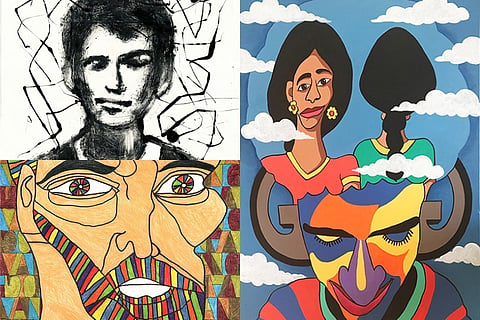

When he sketches, Rohit may make it about the bad day he has had and therefore, paint himself smashing a mirror. If he is in a better mood, it could be about him seeking a girlfriend. His paintings are mostly personal, showing his varied conditions in life.
Anima Nair, who has brought his artwork from Bengaluru to the Kochi Biennale, says there is also a touch of surrealism in his work. She runs the Sense Kaleidoscopes in Bengaluru and knows the work of all nine of her students which is being featured at the Biennale, beginning Friday, in the first ever Outsider Art Show, curated by Bose Krishnamachari.
“The terminology – outsider art – is not much in vogue in India. It is the art practice of people with some kind of disability or another,” Anima says. The organisation she founded with Akshayee Shetty, five to six years ago, is an academy for young people with Autism and Aspergers.
The story that led to the founding of the school is having a son with autism, who is now 18. By the time he was 12, Anima had exhausted all her options, trying all sorts of schools for him, and nothing working out well. “Regular schools don’t give any attention to children with difficulties. And special schools would put kids with all sorts of disabilities together – cerebral palsy, mental retardation, autism – which means none of the children would get any focus,” she says.
She saw so many mothers like her, struggling, trying to figure out what would happen to their child after they die.
“It is a terrible way to live. Every day you wake up scared, not knowing what that day would bring, not knowing what a call from the school would say. Starting a school would give hope to parents like me. We wanted to show that there is a way out,” Anima says.
Her co-founder Akshayee is trained in Scotland in the fine arts and to vocationally work with children with special needs. When Akshayee brought in the skill set, Anima – an engineer and writer – took care of the running of the school. The combination of a professional and a parent worked very well.
The idea is to train the students to make professional artists out of them, to allow them to have a way of earning their livelihood through art. “Not all children with autism can do art. But at least to those who are inclined, here is a way to be financially self-sufficient and productive.”
Anima believed in the potential these kids had. She and Akshayee did not take whatever a child was obsessed with, away from her or him. They let them indulge. “When you allow the child to indulge with their obsession with the right technique in terms of art they keep on producing really good work because they are motivated. With autism, motivation is always a problem, because they don’t understand the value of money, they don’t know why they need to work,” Anima says.
In the exhibition, you’d see a couple of artworks that are about mics, courtesy Shashwat, who is obsessed with them. Each child has a different way of perceiving the world around them. Kalash uses web-like structures in his art, making it more abstract. Ayush does zentangle art. Sakshi, the only girl in the group, and Deeptanshu are print artists. Adarsh does portraits and Shreyas likes caricatures. Pranav – Anima’s son – makes his work geometric and bright. None of it – Anima would tell you – is sympathy art. These are teens and young people in their early 20s with a lot of talent.
“A lot of our children are naturally drawn to art – maybe because they have difficulty in expressing verbally what they want. Maybe they perceive the world so differently from the way we perceive it. Their senses are differently wired. The sounds, this volume (that I speak in) could sound like a huge train going through their ears. Imagine working through a world where everything is too much. So art becomes a way for them to connect to what is around them, a way to communicate. It becomes something that gives them great joy.”